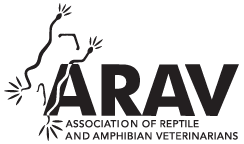Characterizing the Annual Reproductive Cycles of Captive Male Veiled Chameleons (Chamaeleo calyptratus) and Panther Chameleons (Furcifer pardalis)
Chameleons represent one of the most endangered groups of lizards, with most being characterized as threatened or near-threatened. Anthropogenic impacts on their native habitat are responsible for their declines. To protect these animals, we must develop functional assisted reproductive programs. However, a full understanding of their basic reproductive biology is required to develop such a program. This study represents the first attempt at characterizing the reproductive cycles of male chameleons. Sixteen veiled chameleons (Chamaeleo calyptratus) and 16 panther chameleons (Furcifer pardalis) being housed in captivity under static conditions were used for this study. Chameleons were anesthetized twice monthly for semen collection via electroejaculation, blood sampling to measure plasma testosterone concentrations, and ultrasonographic testicular measurements. Plasma testosterone concentrations were found to be significantly different between species (P= 0.02) and in the interaction of species and month (P= 0.04). In veiled chameleons, plasma testosterone concentrations were significantly elevated during October through December, while for panther chameleons plasma testosterone concentrations were elevated in July through September, and December. Electroejaculation success was found to be seasonal in both species. In veiled chameleons, semen collection was highest in April, May, and June, while in panther chameleons semen collection success was highest in March, April, May, and June. Median spermatozoa concentrations for veiled and panther chameleons were 6.66 and 7.52 × 107 sperm/ml, respectively. Motility was lower than expected for both veiled (median 23%) and panther chameleons (median 25%). Spermatozoa clumping was a common finding. The majority of the spermatozoa (mean 51%) were found to have normal morphology. The results of this study confirm that veiled chameleons have a prenuptial reproductive strategy, while panther chameleons have a postnuptial reproductive strategy. Additionally, this study demonstrated that chameleons can undergo repeated electroejaculations under anesthesia, twice monthly, for a year without significant mortality or clinical disease associated with the procedures.Abstract

A. A panther chameleon (Furcifer pardalis) placed in lateral recumbency for the ultrasound examination. B. Ultrasound image of a panther chameleon left testicle. Digital caliper marks outlining testicle: 1. Testicular length: 10.30 mm, 2. Testicular width: 6.11 mm.

Plasma testosterone concentrations (mean ± standard error of mean [SEM]) over 12 mo for veiled chameleons (Chamaeleo calyptratus) (solid black line). Percentage semen collection success for each month (green bars). Baseline testosterone concentration (red dotted line). *Indicates months in which semen collection was significantly higher (P < 0.05).

Plasma testosterone concentrations (mean ± SEM) over 12 mo for panther chameleons (Furcifer pardalis) (solid black line). Percentage semen collection success for each month (green bars). Baseline testosterone concentration (red dotted line). *Indicates months in which semen collection was significantly higher (P < 0.05).

Normal (N) and distal droplet (DD) spermatozoa from a panther chameleon (Furcifer pardalis). Phase contrast, X 200.

Abnormal spermatozoa in a panther chameleon (Furcifer pardalis): macrocephalic head (M), kinked tails (KT), distal droplet (DD), and spermatozoa clump (C). Eosinnigrosin stain, X 1,000.

Spermatozoa clumping (X 40) in a panther chameleon (Furcifer pardalis).

Testicular volumes (mean ± standard deviation [SD]) for veiled chameleons (Chamaeleo calyptratus) over 12 mo. *Indicates months in which testicular volume was significantly higher (P < 0.05).

Testicular volumes (mean ± SD) for panther chameleons (Furcifer pardalis) over 12 mo. *Indicates months in which testicular volume was significantly higher (P < 0.05).



